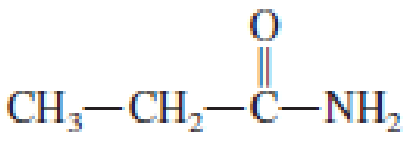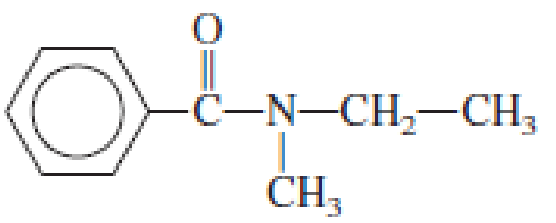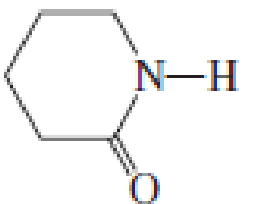
EBK GENERAL, ORGANIC, AND BIOLOGICAL CH
7th Edition
ISBN: 9780100853188
Author: STOKER
Publisher: YUZU
expand_more
expand_more
format_list_bulleted
Concept explainers
Textbook Question
Chapter 17, Problem 17.99EP
Indicate whether or not each of the following compounds contains an amide




Expert Solution & Answer
Want to see the full answer?
Check out a sample textbook solution
Students have asked these similar questions
Determine the rate order and rate constant for sucrose hydrolysis.
Time (hours)
[C6H12O6]
0
0.501
0.500
0.451
1.00
0.404
1.50
0.363
3.00
0.267
Draw the products of the reaction shown below. Use wedge and dash bonds
to indicate stereochemistry. Ignore inorganic byproducts.
OSO4 (cat)
(CH3)3COOH
Select to Draw
ઘ
Calculate the reaction rate for selenious acid, H2SeO3, if 0.1150 M I-1 decreases to 0.0770 M in 12.0 minutes.
H2SeO3(aq) + 6I-1(aq) + 4H+1(aq) ⟶ Se(s) + 2I3-1(aq) + 3H2O(l)
Chapter 17 Solutions
EBK GENERAL, ORGANIC, AND BIOLOGICAL CH
Ch. 17.1 - Prob. 1QQCh. 17.1 - Prob. 2QQCh. 17.2 - Prob. 1QQCh. 17.2 - Prob. 2QQCh. 17.2 - Prob. 3QQCh. 17.2 - Prob. 4QQCh. 17.3 - Prob. 1QQCh. 17.3 - Prob. 2QQCh. 17.3 - Prob. 3QQCh. 17.3 - Prob. 4QQ
Ch. 17.4 - Prob. 1QQCh. 17.4 - Prob. 2QQCh. 17.5 - Prob. 1QQCh. 17.5 - Prob. 2QQCh. 17.5 - Prob. 3QQCh. 17.6 - Prob. 1QQCh. 17.6 - Prob. 2QQCh. 17.6 - Prob. 3QQCh. 17.7 - Prob. 1QQCh. 17.7 - Prob. 2QQCh. 17.7 - Prob. 3QQCh. 17.8 - Prob. 1QQCh. 17.8 - Prob. 2QQCh. 17.8 - Prob. 3QQCh. 17.8 - Prob. 4QQCh. 17.9 - Prob. 1QQCh. 17.9 - Prob. 2QQCh. 17.10 - Prob. 1QQCh. 17.10 - Prob. 2QQCh. 17.10 - Prob. 3QQCh. 17.10 - Prob. 4QQCh. 17.11 - Prob. 1QQCh. 17.11 - Prob. 2QQCh. 17.11 - Prob. 3QQCh. 17.12 - Prob. 1QQCh. 17.12 - Prob. 2QQCh. 17.12 - Prob. 3QQCh. 17.12 - Prob. 4QQCh. 17.13 - Prob. 1QQCh. 17.13 - Prob. 2QQCh. 17.13 - Prob. 3QQCh. 17.13 - Prob. 4QQCh. 17.14 - Prob. 1QQCh. 17.14 - Prob. 2QQCh. 17.14 - Prob. 3QQCh. 17.15 - Prob. 1QQCh. 17.15 - Prob. 2QQCh. 17.16 - Prob. 1QQCh. 17.16 - Prob. 2QQCh. 17.16 - Prob. 3QQCh. 17.17 - Prob. 1QQCh. 17.17 - Prob. 2QQCh. 17.17 - Prob. 3QQCh. 17.18 - Prob. 1QQCh. 17.18 - Prob. 2QQCh. 17.18 - Prob. 3QQCh. 17.19 - Prob. 1QQCh. 17.19 - Prob. 2QQCh. 17.19 - Prob. 3QQCh. 17.19 - Prob. 4QQCh. 17 - Prob. 17.1EPCh. 17 - Prob. 17.2EPCh. 17 - Prob. 17.3EPCh. 17 - Prob. 17.4EPCh. 17 - Prob. 17.5EPCh. 17 - Prob. 17.6EPCh. 17 - Indicate whether or not each of the following...Ch. 17 - Indicate whether or not each of the following...Ch. 17 - Prob. 17.9EPCh. 17 - Prob. 17.10EPCh. 17 - Prob. 17.11EPCh. 17 - Prob. 17.12EPCh. 17 - Prob. 17.13EPCh. 17 - Prob. 17.14EPCh. 17 - Prob. 17.15EPCh. 17 - Assign a common name to each of the following...Ch. 17 - Prob. 17.17EPCh. 17 - Prob. 17.18EPCh. 17 - Prob. 17.19EPCh. 17 - Prob. 17.20EPCh. 17 - Prob. 17.21EPCh. 17 - Prob. 17.22EPCh. 17 - Prob. 17.23EPCh. 17 - Prob. 17.24EPCh. 17 - Prob. 17.25EPCh. 17 - Prob. 17.26EPCh. 17 - Prob. 17.27EPCh. 17 - Prob. 17.28EPCh. 17 - Prob. 17.29EPCh. 17 - Prob. 17.30EPCh. 17 - Prob. 17.31EPCh. 17 - Prob. 17.32EPCh. 17 - Prob. 17.33EPCh. 17 - Prob. 17.34EPCh. 17 - Determine the maximum number of hydrogen bonds...Ch. 17 - Prob. 17.36EPCh. 17 - Prob. 17.37EPCh. 17 - Prob. 17.38EPCh. 17 - Prob. 17.39EPCh. 17 - Prob. 17.40EPCh. 17 - Prob. 17.41EPCh. 17 - Prob. 17.42EPCh. 17 - Prob. 17.43EPCh. 17 - Prob. 17.44EPCh. 17 - Prob. 17.45EPCh. 17 - Prob. 17.46EPCh. 17 - Prob. 17.47EPCh. 17 - Prob. 17.48EPCh. 17 - Prob. 17.49EPCh. 17 - Prob. 17.50EPCh. 17 - Prob. 17.51EPCh. 17 - Prob. 17.52EPCh. 17 - Prob. 17.53EPCh. 17 - Prob. 17.54EPCh. 17 - Prob. 17.55EPCh. 17 - Prob. 17.56EPCh. 17 - Prob. 17.57EPCh. 17 - Prob. 17.58EPCh. 17 - Prob. 17.59EPCh. 17 - Prob. 17.60EPCh. 17 - Prob. 17.61EPCh. 17 - Prob. 17.62EPCh. 17 - Prob. 17.63EPCh. 17 - Prob. 17.64EPCh. 17 - Prob. 17.65EPCh. 17 - Prob. 17.66EPCh. 17 - Prob. 17.67EPCh. 17 - Prob. 17.68EPCh. 17 - Prob. 17.69EPCh. 17 - Prob. 17.70EPCh. 17 - Prob. 17.71EPCh. 17 - Prob. 17.72EPCh. 17 - Prob. 17.73EPCh. 17 - Prob. 17.74EPCh. 17 - Prob. 17.75EPCh. 17 - Prob. 17.76EPCh. 17 - Prob. 17.77EPCh. 17 - Prob. 17.78EPCh. 17 - Prob. 17.79EPCh. 17 - Prob. 17.80EPCh. 17 - Prob. 17.81EPCh. 17 - Prob. 17.82EPCh. 17 - Prob. 17.83EPCh. 17 - Prob. 17.84EPCh. 17 - Prob. 17.85EPCh. 17 - Prob. 17.86EPCh. 17 - Prob. 17.87EPCh. 17 - Prob. 17.88EPCh. 17 - Prob. 17.89EPCh. 17 - Prob. 17.90EPCh. 17 - Prob. 17.91EPCh. 17 - Prob. 17.92EPCh. 17 - Prob. 17.93EPCh. 17 - Prob. 17.94EPCh. 17 - Prob. 17.95EPCh. 17 - Prob. 17.96EPCh. 17 - Prob. 17.97EPCh. 17 - Prob. 17.98EPCh. 17 - Indicate whether or not each of the following...Ch. 17 - Indicate whether or not each of the following...Ch. 17 - Classify each of the following amides as...Ch. 17 - Classify each of the following amides as...Ch. 17 - Classify each of the amides in Problem 17-101 as a...Ch. 17 - Prob. 17.104EPCh. 17 - Prob. 17.105EPCh. 17 - Prob. 17.106EPCh. 17 - Prob. 17.107EPCh. 17 - Prob. 17.108EPCh. 17 - Prob. 17.109EPCh. 17 - Prob. 17.110EPCh. 17 - Assign an IUPAC name to each of the following...Ch. 17 - Assign an IUPAC name to each of the following...Ch. 17 - Prob. 17.113EPCh. 17 - Prob. 17.114EPCh. 17 - Prob. 17.115EPCh. 17 - Prob. 17.116EPCh. 17 - Prob. 17.117EPCh. 17 - Prob. 17.118EPCh. 17 - Prob. 17.119EPCh. 17 - What is the relationship between the acronym DEET...Ch. 17 - Prob. 17.121EPCh. 17 - Prob. 17.122EPCh. 17 - Prob. 17.123EPCh. 17 - Prob. 17.124EPCh. 17 - Prob. 17.125EPCh. 17 - Prob. 17.126EPCh. 17 - Prob. 17.127EPCh. 17 - Prob. 17.128EPCh. 17 - Prob. 17.129EPCh. 17 - Prob. 17.130EPCh. 17 - Prob. 17.131EPCh. 17 - Prob. 17.132EPCh. 17 - Prob. 17.133EPCh. 17 - Prob. 17.134EPCh. 17 - Prob. 17.135EPCh. 17 - Prob. 17.136EPCh. 17 - Prob. 17.137EPCh. 17 - Prob. 17.138EPCh. 17 - Prob. 17.139EPCh. 17 - Prob. 17.140EPCh. 17 - Prob. 17.141EPCh. 17 - Prob. 17.142EPCh. 17 - Prob. 17.143EPCh. 17 - Prob. 17.144EPCh. 17 - Prob. 17.145EPCh. 17 - Prob. 17.146EPCh. 17 - Prob. 17.147EPCh. 17 - Prob. 17.148EPCh. 17 - Prob. 17.149EPCh. 17 - Prob. 17.150EPCh. 17 - Prob. 17.151EPCh. 17 - Prob. 17.152EPCh. 17 - Prob. 17.153EPCh. 17 - Prob. 17.154EP
Knowledge Booster
Learn more about
Need a deep-dive on the concept behind this application? Look no further. Learn more about this topic, biology and related others by exploring similar questions and additional content below.Similar questions
- Problem 5-31 Which of the following objects are chiral? (a) A basketball (d) A golf club (b) A fork (c) A wine glass (e) A spiral staircase (f) A snowflake Problem 5-32 Which of the following compounds are chiral? Draw them, and label the chirality centers. (a) 2,4-Dimethylheptane (b) 5-Ethyl-3,3-dimethylheptane (c) cis-1,4-Dichlorocyclohexane Problem 5-33 Draw chiral molecules that meet the following descriptions: (a) A chloroalkane, C5H11Cl (c) An alkene, C6H12 (b) An alcohol, C6H140 (d) An alkane, C8H18 Problem 5-36 Erythronolide B is the biological precursor of erythromycin, a broad-spectrum antibiotic. How H3C CH3 many chirality centers does erythronolide B have? OH Identify them. H3C -CH3 OH Erythronolide B H3C. H3C. OH OH CH3arrow_forwardPLEASE HELP! URGENT! PLEASE RESPOND!arrow_forward2. Propose a mechanism for this reaction. ہلی سے ملی N H (excess)arrow_forward
- Steps and explanationn please.arrow_forwardProblem 5-48 Assign R or S configurations to the chirality centers in ascorbic acid (vitamin C). OH H OH HO CH2OH Ascorbic acid O H Problem 5-49 Assign R or S stereochemistry to the chirality centers in the following Newman projections: H Cl H CH3 H3C. OH H3C (a) H H H3C (b) CH3 H Problem 5-52 Draw the meso form of each of the following molecules, and indicate the plane of symmetry in each: OH OH (a) CH3CHCH2CH2CHCH3 CH3 H3C. -OH (c) H3C CH3 (b) Problem 5-66 Assign R or S configurations to the chiral centers in cephalexin, trade-named Keflex, the most widely prescribed antibiotic in the United States. H2N H IHH S Cephalexin N. CH3 CO₂Harrow_forwardSteps and explanationn please.arrow_forward
arrow_back_ios
SEE MORE QUESTIONS
arrow_forward_ios
Recommended textbooks for you
 General, Organic, and Biological ChemistryChemistryISBN:9781285853918Author:H. Stephen StokerPublisher:Cengage Learning
General, Organic, and Biological ChemistryChemistryISBN:9781285853918Author:H. Stephen StokerPublisher:Cengage Learning Organic And Biological ChemistryChemistryISBN:9781305081079Author:STOKER, H. Stephen (howard Stephen)Publisher:Cengage Learning,
Organic And Biological ChemistryChemistryISBN:9781305081079Author:STOKER, H. Stephen (howard Stephen)Publisher:Cengage Learning, Chemistry for Today: General, Organic, and Bioche...ChemistryISBN:9781305960060Author:Spencer L. Seager, Michael R. Slabaugh, Maren S. HansenPublisher:Cengage Learning
Chemistry for Today: General, Organic, and Bioche...ChemistryISBN:9781305960060Author:Spencer L. Seager, Michael R. Slabaugh, Maren S. HansenPublisher:Cengage Learning

General, Organic, and Biological Chemistry
Chemistry
ISBN:9781285853918
Author:H. Stephen Stoker
Publisher:Cengage Learning

Organic And Biological Chemistry
Chemistry
ISBN:9781305081079
Author:STOKER, H. Stephen (howard Stephen)
Publisher:Cengage Learning,

Chemistry for Today: General, Organic, and Bioche...
Chemistry
ISBN:9781305960060
Author:Spencer L. Seager, Michael R. Slabaugh, Maren S. Hansen
Publisher:Cengage Learning
Nomenclature: Crash Course Chemistry #44; Author: CrashCourse;https://www.youtube.com/watch?v=U7wavimfNFE;License: Standard YouTube License, CC-BY